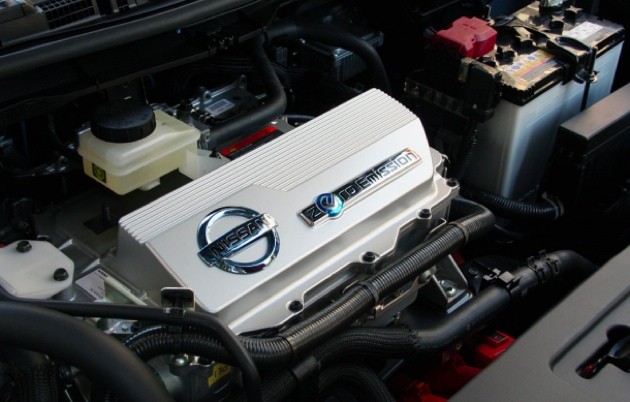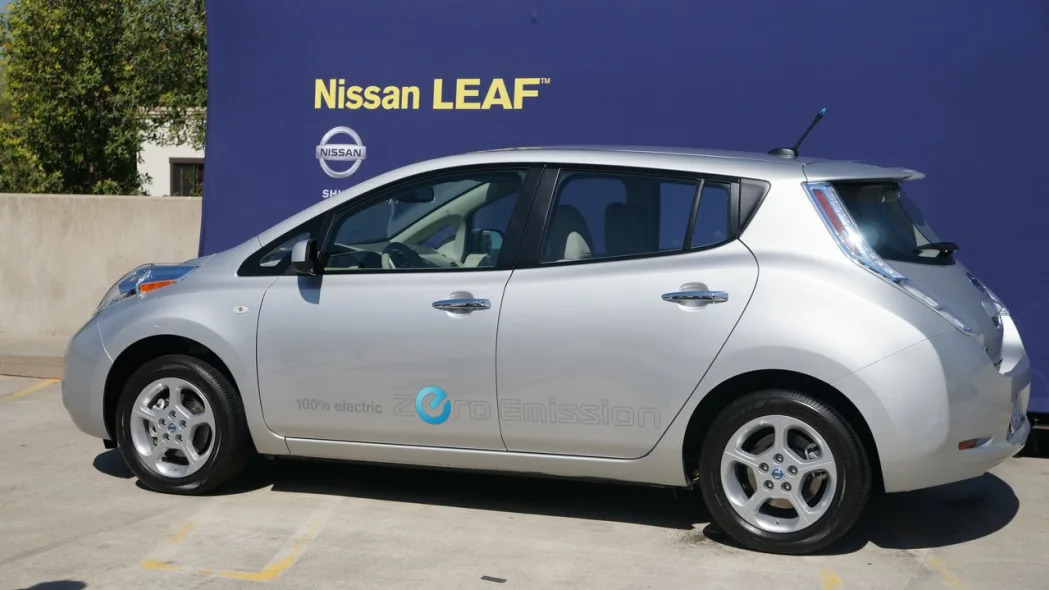Having just completed the Nissan Drive Electric tour showcasing the all-electric Nissan Leaf, one particular feature made a more lasting impression on me than all of the others. It wasn't the LED headlight or taillights, the Microsoft-sourced interface that points to charging stations, or the trick thermal management system (a bane of electric vehicles – more on this later). The feature that made the most lasting impression was the "valve cover" under the hood.
Now before the Leaf fans start up their "kill him with fire!" flamethrowers, allow me to explain. I get that a large part of Nissan's strategy for the Leaf has been to make it as smooth as possible to transition from the conventional gasoline-powered cars that people are already used to buying and owning. After all, the Leaf will be a first-of-its-kind mass market car that is coming to market at a time when the entire industry is cautiously still dipping its collective toe in the water with battery-powered and extended-range electric vehicles. In that sense, the car should feel familiar and comfortable, and in my previous article on the Leaf, I applauded Nissan for rising to the challenge of striving to make the Leaf feel as familiar as an old pair of Levis.
However, there is something else about Levis that may have been overlooked in Nissan's attempts to design familiarity into the Leaf. Levis are authentic and honest. By contrast, with the Leaf, there is something inherently contrived and off-putting about feigned familiarity – especially when it comes to the very features that define the car. Read on after the jump for the reasons why.
I get why the Leaf couldn't and shouldn't look like a spaceship (sorry, Aptera) or feature a spokeless steering wheel or any number of other Jetsons-like finishing touches. Despite its present day magnetic pull with early adopters, in the long term this car isn't about appealing to the "I am living in the future now" crowd – at least not overtly so. Rather, as evidenced by the abundance of Toyota Priuses parked in the lot this morning, the Leaf should be about taking the next logical step in the progression away from parallel hybrids into a car that doesn't get its motivation from exploding dino juice. Given that, I'm willing to forgive and look beyond its conservative interior and exterior, and focus on what powers this ride down the road – the motor.
For this, let's turn to a point of historic comparison. When the television was introduced, and for literally decades afterwards, it was not uncommon for them to be housed in wooden cabinets or, in later, years, to come with faux wood finishes. The thinking was, the TV was something new and alien. So, to integrate it with our lives and, indeed, the fabric of our society, it needed first and foremost to integrate with our living rooms. Ergo, the TV became a piece of wooden furniture.
Which brings us back to the Leaf's "valve cover." Nissan has played it conservatively so as to not offend mainstream consumers with the Leaf, but in so doing, missed an opportunity to highlight the very part of the car of which its owners could be the most proud – it's motor. Arguably, this is the very part of the Leaf that, together with the battery pack buried deep under the floorboards, defines the car.
As I found myself poking around looking for a dipstick to check electrons, a couple of alternate scenarios occurred to me about what Nissan could have done with the Leaf's "engine bay." First, given its prominent placement under the hood, the electric motor could have been shown off with special lighting and/or a polished housing, to showcase how compact and efficient it really is when compared to the hulking and complicated combustion engines we are used to seeing. That impression of simplicity and efficiency expressed in the tiny and tidy motor could stand in for the very value proposition of the car itself – something that leverages technology to make our lives simpler and easier, not complicated or full of belts and hoses and greasable fittings to keep tabs on.

Another direction Nissan could have gone with this might have been to make the engine compartment an area of no concern to its owner, accessible exclusively to the dealer via special fittings that the average consumer couldn't or wouldn't ever be interested in removing. Going down this path would send the message that the Leaf is so hassle free – only needing to be brought in for a check-up once a year – that the old habit of popping the hood is now a pleasant anachronism. As an enthusiast who can often be found admiring a form-follows-function engine bay with an array of individual throttle bodies or a golden tinged tubular exhaust manifold with just the right burnish – and as much as it pains me to say this – the Leaf really could have been a hoodless car and used that to very feature to amplify its appeal.
Instead, we get the fake valve cover. We also get a fake transmission tunnel that the "shifter" (with no mechanical linkage) sits in. Now, far be it from me to propose a return of the bench seat, but the point is, designing in a transmission tunnel into a car that has nothing to house inside it just to make it feel more "car like" is another missed opportunity. Had the tunnel been carried over from an existing platform that had at one point housed a combustion engine (á la the Mini E) this would have been forgivable – but in a car that started as a clean sheet of paper and was meant to be an EV from the start – not so much.
On the plus side, Nissan did an admirable job of highlighting the absence of exhaust pipes with its clever under tray and integrated rear diffuser, leaving no doubt, at least when seen from the outside, that this is a car that will never, ever be responsible for a garage suicide attempt – depressed Chevrolet Volt owners, don't get any ideas.
If Nissan might be lacking in imagination, it has not scrimped in the technology department, despite what my esteemed former colleague, Darryl Siry, called out in a blog post back in January. In his article, Siry chastised the Leaf for not having active thermal management of its battery pack and argued, based on this lack of liquid cooling, that the Leaf's 100-mile range estimate was likely inflated. Now that we have real-world reports of the car handily exceeding this number (Plugincars.com saw 116 miles in their test) we now know that 100 miles was anything but a hope-and-a-prayer figure, even if Nissan is carefully explaining the factors that will affect your range. So, what got Siry to call the range into question? He expressed concern over the lack of active thermal management for the Leaf's battery pack, contrasting it with the Tesla Roadster's liquid-cooled pack. Siry's conclusion was that the pack was more likely to overheat and limit range with this design, and it was an obvious sign of cost cutting.
As it turns out, he may not have been giving credit where credit is due. According to a Nissan project engineer at the San Jose Nissan Drive Electric event, the big difference between the Leaf's battery cells and Tesla's is that while the Tesla ESS (Energy Storage System) houses 18650 cells that are individually packaged in metal casings, the cells Nissan uses in the Leaf are in laminate sheets, which, by virtue of their surface area, are able to shed heat much more efficiently than the Tesla's cells – hence, no liquid cooling needed. When I asked about the motor itself, which in Tesla's case, is often the weak link in the thermal chain as it is air cooled, puts a damper on prolonged bouts of spirited driving, the Leaf has a liquid cooled motor, obviating this problem. Nissan has succeeded in bringing this technology to market at an unparalleled price point – now it just needs to shed the wood cabinetry. As lesson, apparently that also need be learned by Chevy with the Volt's vestigial grill.
So, there you have it, the Leaf is a technically sophisticated TV fits neatly fit inside a burled wooden cabinet.
***
David Vespremi is an accomplished brand marketing strategist working across both automotive and cleantech industries. He served as Marketing Director for K&N Engineering, Driverside.com and Tendo Communcations, in support of client American Honda, and as the Director of Communications for Tesla Motors. David's work has garnered 2006 Addy and Webby awards for K&N Engineering and PR Week finalist nominations for both 2008 Brand Launch of the Year and 2008 Technology Launch of the Year for Tesla Motor. He now runs his own San Francisco Bay Area-based marketing agency, BoostedGroup LLC, providing marketing solutions and support for automotive and cleantech clients.
Leaf Drive Tour Photos by Jonas Dalidd / Motor Bay Leaf Photo by Damon Lavrinc, Both Copyright ©2010 Weblogs, Inc. Television Image: ellenm1, C.C. License 2.0.




Sign in to post
Please sign in to leave a comment.
Continue